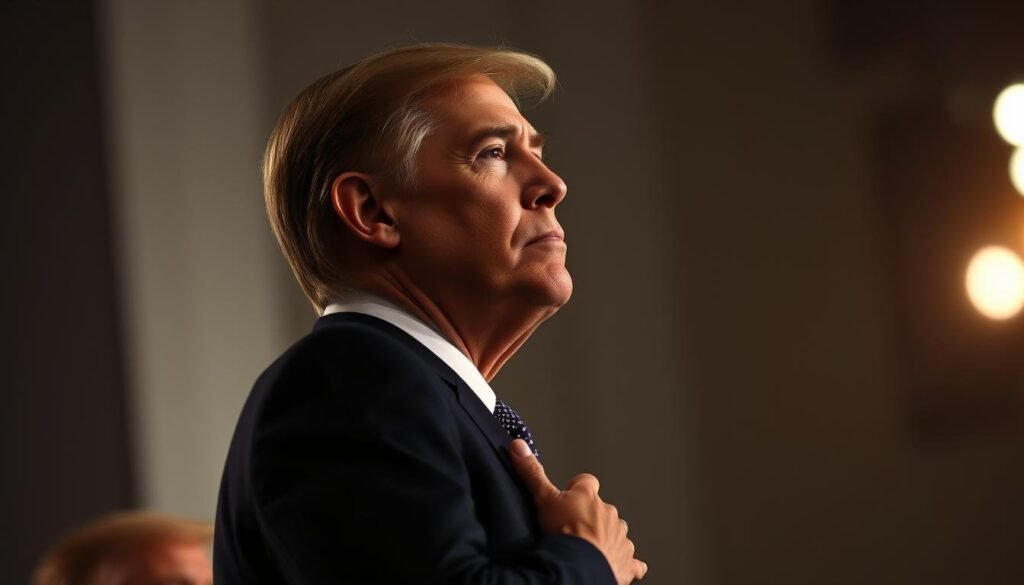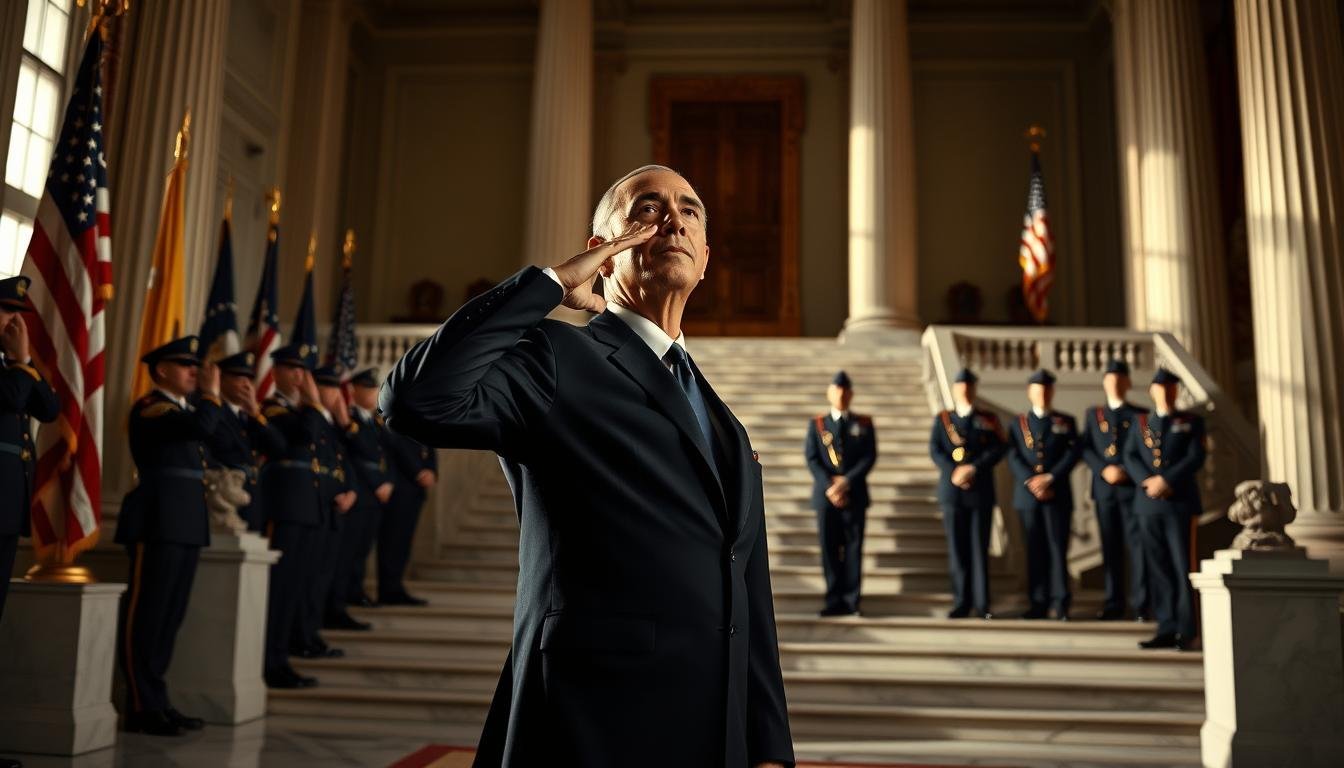Should the President Salute During the National Anthem? Have you ever thought about the rules for presidential protocol and national anthem etiquette? The question of whether the President should salute during the national anthem has caused a lot of talk.
It’s important to know the history and rules that guide the President’s actions. As you learn more, you’ll see why national symbols matter. You’ll also understand how the President’s actions affect national unity and respect for the flag.
By looking at past examples and official rules, you’ll get a better grasp of this complex issue. You’ll see the points made by both sides of the debate. [Should the President Salute During the National Anthem?]
Contents
- 1 Presidential Protocol and National Symbols
- 2 The History of Presidential Behavior During the National Anthem
- 3 Official Guidelines on Presidential Conduct
- 4 Should the President Salute During National Anthem? The Debate
- 5 Presidential Anthem Behavior: Historical Examples
- 6 Conclusion: Should the President Salute During the National Anthem?
- 7 FAQ
- 7.1 What is the protocol for the President during the national anthem?
- 7.2 Is the President required to salute during the national anthem?
- 7.3 What is the significance of the national anthem in American culture?
- 7.4 How have past Presidents behaved during the national anthem?
- 7.5 What are the arguments for and against the President saluting during the national anthem?
- 7.6 Are there any official guidelines governing the President’s behavior during the national anthem?
- 7.7 How does the President’s behavior during the national anthem impact national unity?
Presidential Protocol and National Symbols
Exploring presidential protocol reveals the importance of national symbols in American culture. The President’s actions at official events, like the national anthem, follow strict rules and traditions.
National symbols, such as the flag, hold a special place in American culture. The flag, for instance, is a powerful symbol that evokes feelings of patriotism and loyalty.
Significance of National Symbols
It’s key to understand the importance of national symbols in the debate over the President’s actions during the national anthem. These symbols are more than just representations. They carry deep historical significance and emotional value.
| National Symbol | Significance | Historical Context |
|---|---|---|
| The Flag | Represents national unity and identity | Adopted on June 14, 1777 |
| The National Anthem | Symbolizes patriotism and loyalty | Adopted on March 3, 1931 |
By looking at official guidelines and historical examples, you can better understand the complexities of the President’s behavior during the national anthem.
The History of Presidential Behavior During the National Anthem
Historically, the President’s actions during the national anthem followed certain rules and traditions. It’s interesting to see how these customs have changed over time. The early years of America set the stage for how Presidents behave during the anthem.
In the 19th and early 20th centuries, there were no strict rules for the President’s actions. It wasn’t until later that clear guidelines started to appear. For example, the U.S. Flag Code, adopted in 1942, helps guide how to treat the flag. This indirectly affects how Presidents act during the anthem.
The table below shows important moments in the evolution of presidential protocol during the national anthem. [Should the President Salute During the National Anthem?]
| Year | Event | Description |
|---|---|---|
| 1942 | Adoption of the U.S. Flag Code | Established guidelines for the display and respect of the U.S. flag. |
| 1950s-60s | Formalization of Presidential Protocol | Specific rules and customs for presidential behavior during national events began to take shape. |
| 2000s | Modernization of Protocol | Adjustments to reflect contemporary societal norms and expectations. |
Understanding these historical developments gives us insight into the complexities of presidential conduct during the national anthem. These changes reflect broader shifts in American culture and values.
Official Guidelines on Presidential Conduct
It’s key to know the rules for presidential behavior during the national anthem. These rules help the President act with respect for national symbols.
The guidelines stress the need for respect and dignity at national events. The President must follow certain steps to keep the office’s dignity.
- Standing at attention during the national anthem
- Saluting if in uniform
- Removing any headwear
- Showing respect to the flag
These rules aim to boost national unity and respect for the anthem. By sticking to these rules, the President shows the public what to do. [Should the President Salute During the National Anthem?]
Implications of Official Guidelines
The impact of these rules is big. They keep the presidency’s honor and help unite the nation. They also clear up what’s expected at national events, avoiding confusion.
Key points to consider:
- The guidelines are part of a bigger set of rules for the President’s actions.
- They make sure national symbols are respected.
- Following these rules is crucial for national unity.
By knowing and following these rules, the President can build respect and unity among Americans.
Should the President Salute During National Anthem? The Debate
Should the President salute during the national anthem? This question starts a deep debate. Some say it shows respect for the flag and brings the nation together. They see it as a way to honor the nation’s symbols.
Others say saluting isn’t required by law. They think the President should follow rules and traditions, not just show patriotism. [Should the President Salute During the National Anthem?]

Looking at the President’s actions during the national anthem is important. We need to think about history and official rules. The debate also talks about how the President’s actions affect national unity and respect for the flag.
Arguments For and Against the Salute
Those who support the salute think it brings people together. They say it shows the President’s example to the nation.
But, those against the salute worry it might cross the line of power or be too much patriotism. [Should the President Salute During the National Anthem?]
| Aspect | Arguments For Salute | Arguments Against Salute |
|---|---|---|
| National Unity | Fosters unity among citizens | Not a constitutional requirement |
| Presidential Protocol | Demonstrates respect for national symbols | May be seen as an infringement on separation of powers |
| Patriotism | Shows patriotism and honors the nation’s symbols | Can be seen as an unnecessary display |
The debate shows it’s a complex issue. It involves rules for the national anthem, presidential actions, and patriotism. By looking at all sides, we can understand the depth of this topic.
Presidential Anthem Behavior: Historical Examples
Looking at how past Presidents acted during the national anthem gives us insight. It shows how the tradition has changed over time. By studying their actions, we can understand the importance of this national symbol.
President Franklin D. Roosevelt, during World War II, always showed respect for the flag. He stood at attention when the national anthem played. This set a precedent for future Presidents.
On the other hand, some Presidents were more casual. For example, President Ronald Reagan placed his hand on his heart during the anthem. This showed respect in his own way.
These different behaviors tell us a lot about the debate on the President’s salute during the national anthem. By looking at past Presidents’ actions, we see the importance of protocol in American culture.
The way Presidents behave during the national anthem shows how national symbols evolve. These examples show the President’s actions are key to national unity and respect for the flag.
Conclusion: Should the President Salute During the National Anthem?
You’ve looked into the President’s actions during the national anthem. You’ve seen the historical context, official rules, and the role of presidential protocol. This debate shows how important it is to know the rules of the national anthem and its role in unity.
The President’s choice to salute or not salute is based on many things. These include the rules for the President and respect for the flag. Knowing these helps us understand the President’s part in showing national unity.
The President’s actions during the national anthem show the country’s values and respect for its symbols. Thinking about this issue helps us see how the President’s actions affect how we see the flag and national unity.
See Also: Can the President Be Sued for Defamation?
FAQ
What is the protocol for the President during the national anthem?
The President is expected to show respect during the national anthem. The specific protocol can change based on the occasion and circumstances.
Is the President required to salute during the national anthem?
Official guidelines say the President doesn’t have to salute during the national anthem. This is because they are the commander-in-chief. Saluting is usually done by military personnel or officials towards the President or the flag.
What is the significance of the national anthem in American culture?
The national anthem symbolizes national unity and patriotism. It represents the country’s history and values. [Should the President Salute During the National Anthem?]
How have past Presidents behaved during the national anthem?
Past Presidents have shown different levels of participation during the national anthem. Some have saluted, while others haven’t. This shows how presidential protocol has evolved over time.
What are the arguments for and against the President saluting during the national anthem?
Some argue that saluting shows respect for the flag and national unity. Others say it’s not required by the Constitution and might seem like a gesture of militarism.
Are there any official guidelines governing the President’s behavior during the national anthem?
Yes, there are official guidelines for the President’s behavior during the national anthem. They outline the expectations for respect and protocol. [Should the President Salute During the National Anthem?]
How does the President’s behavior during the national anthem impact national unity?
The President’s actions during the national anthem can symbolize national unity. Some believe saluting shows respect, while others see it as a gesture of division.

Hi, I am Tatum Bradford from Washington. I have a background in political science and work as a senior revenue officer. I love learning about U.S. presidents and sharing interesting facts about political history.

